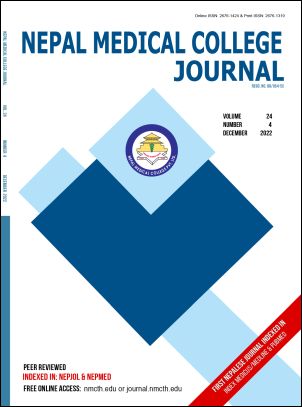Digital Eye strain among Undergraduate Medical students of Nepal Medical College and Teaching Hospital during COVID-19 Pandemic
DOI:
https://doi.org/10.3126/nmcj.v24i4.50594Keywords:
Digital eyestrain, Computer vision syndrome, Digital devices, 20-20-20 rule, Covid-19Abstract
During Covid-19 Pandemic, there was declaration of lockdown which led to increased usage of digital devices due to starting of online classes. Increased duration of digital device usage predisposed students to Digital eye strain (DES). This study aimed at estimation of the prevalence of DES among medical students of Nepal Medical College and Teaching Hospital during Covid pandemic. It also analyzed the pattern of digital device usage, risk factors for DES, awareness and practice of preventive measures taken by students during online classes. This was a cross-sectional questionnaire-based survey which included one hundred and sixteen undergraduate medical students. The mean age of the students was 22±1.30 years. Sixty-two students (53.4%) were male and fifty-four (46.6%) were female. There was a significant increase in the duration of digital device usage during Covid -period as compared to pre-Covid period (P=<0.001). The prevalence of the DES was 68.1% of which 60.34% had mild DES and 7.76% had moderate DES. The most common ocular symptoms were burning sensation (69.8%) followed by eyesight worsening (60.3%) and eyepain (56%). This study didn’t find significant association between DES and its risk factors like duration of digital device usage, distance from screen, posture, frequency of break and level of screen during online classes. Preventive measures like uses of lubricating eyedrop and use of anti-reflective coated glasses/ blue ray cut glasses were significantly associated with less frequency of DES (P=0.03,0.01 respectively). DES is an emerging eye health problem due to increase screentime exposure, so limitation of screentime and practice of 20-20-20 rule is recommended to reduce DES related symptoms.
Downloads
Downloads
Published
How to Cite
Issue
Section
License
Copyright (c) 2022 Nepal Medical College Journal

This work is licensed under a Creative Commons Attribution 4.0 International License.
This license enables reusers to distribute, remix, adapt, and build upon the material in any medium or format, so long as attribution is given to the creator. The license allows for commercial use.




